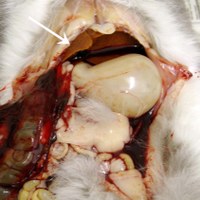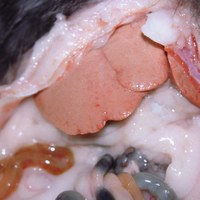Hepatic lipidosis
Hepatic lipidosis is the end point of gut stasis, which is associated with loss of appetite and reduced or absent faecal output. It is not really a cause of sudden death but will be a cause of unexpected death. Owners can easily miss a rabbit that is not eating or defaecating normally, especially if the rabbit lives with companions, so the owners are not aware of a problem until the rabbit is dying. Gut stasis is secondary problem and the underlying reason may be detected during post-mortem examination. Dental disease is a common cause of gut stasis. On post-mortem examination, the liver is swollen and very pale. Occasionally there may be abdominal haemorrhage if the liver has ruptured (see right).
.


